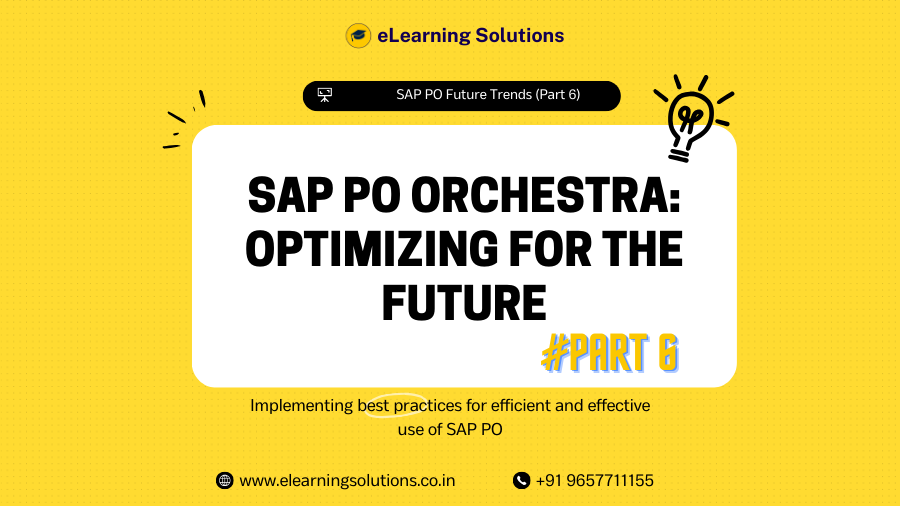Throughout this blog series, we’ve explored the magic of SAP PO, its functionalities, and its potential to orchestrate seamless communication across your IT landscape. Now, it’s time to shift gears and focus on optimizing your SAP PO usage for the future. In this blog, we’ll delve into SAP PO Future Trends, best practices, explore its role in evolving IT environments, and shed light on emerging trends in process orchestration.
Best Practices for a Well-Tuned SAP PO Future Trends
Just like any finely tuned orchestra, SAP PO requires best practices to ensure smooth operation and optimal performance:
- Standardization and Reusability: Develop a standardized approach to message mapping and interface design. This promotes consistency, reduces development time, and simplifies maintenance.
- Reusability of Interfaces and Mappings: Leverage pre-built content and reusable components whenever possible. This reduces development effort and minimizes the risk of errors.
- Thorough Testing and Monitoring: Implement a robust testing strategy to identify and rectify errors before deployment. Continuously monitor message flow and performance to proactively address any issues.
- Documentation and Version Control: Maintain clear and comprehensive documentation for your integration scenarios. Implement version control to track changes and ensure rollbacks if necessary.
- Security Best Practices: Enforce data security measures to protect sensitive information during message exchange. Utilize encryption and access controls to safeguard your data assets.
By adhering to these best practices, you can optimize your SAP PO implementation, ensuring reliable performance, efficient maintenance, and a future-proof integration landscape.
Scaling Up for the Hybrid and Multi-Cloud Era
As IT landscapes evolve, SAP PO continues to play a pivotal role:
- Hybrid Integration: Connect on-premise SAP systems with cloud applications and services. SAP PO acts as the central integration hub, orchestrating data flow between both worlds. This facilitates a hybrid IT strategy, allowing you to leverage the benefits of cloud computing while preserving your existing on-premise investments.
- Multi-Cloud Integration: SAP PO can integrate with various cloud platforms and providers. This empowers you to choose the best cloud solution for each specific need, fostering a flexible and multi-cloud integration strategy.
- API Management: SAP PO can be integrated with API management platforms to manage APIs exposed by your SAP and non-SAP applications. This enables centralized control over API access, security, and lifecycle management.
By embracing SAP PO’s capabilities, you can ensure seamless integration within your hybrid and multi-cloud environment, maximizing the value of your diverse IT infrastructure.
A Glimpse into SAP PO Future Trends
The world of process orchestration is constantly evolving. Here are some exciting trends to watch:
- Low-Code/No-Code Development: The rise of low-code/no-code development platforms simplifies integration development, making it accessible to a broader range of users. SAP PO can integrate with these platforms, empowering citizen developers to build basic integrations.
- Artificial Intelligence (AI) and Machine Learning (ML): Integrating AI and ML capabilities into SAP PO can lead to intelligent process automation. AI can analyze historical data to optimize routing rules, identify and rectify errors proactively, and even predict potential integration issues.
- Event-Driven Architecture (EDA): Event-driven architectures are gaining traction. SAP PO can be adapted to handle event-driven integrations, allowing applications to react to real-time events and data changes more efficiently.
These emerging trends hold immense potential to transform how SAP PO orchestrates integrations in the future. By staying abreast of these advancements, you can position your organization to leverage the latest capabilities and further optimize your integration landscape.
Conclusion
SAP PO remains a powerful tool for building robust and scalable integrations. By adopting best practices for efficient usage and embracing its role in hybrid and multi-cloud environments, you can ensure your integration strategy remains future-proof. As the world of process orchestration embraces AI, ML, and event-driven architectures, SAP PO is well-positioned to evolve and empower organizations to thrive in the ever-changing IT landscape.
This concludes our exploration of the SAP PO Orchestra. We hope this blog series has equipped you with valuable insights into its functionalities, best practices, and future potential. With careful planning, continuous optimization, and a keen eye on emerging trends, you can leverage SAP PO to unlock the power of seamless integration and drive success within your organization.



 WhatsApp us
WhatsApp us